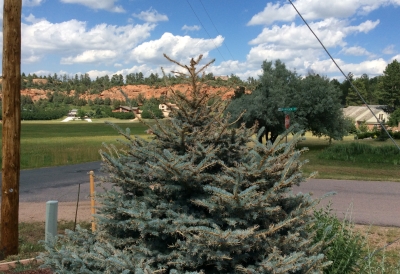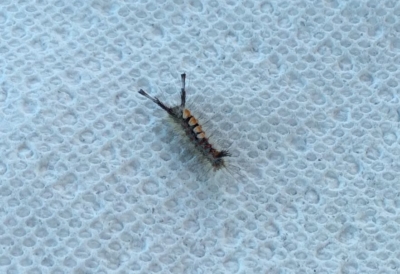Tussock Moth Control
Tussock moth control is an important component of any property owner in urban Colorado. The Douglas Fir tussock moth is a common pest in Colorado. The Tussock moth caterpillar (Orgyia psuedotsugata) eat the needles of spruce, Douglas fir, and true fir trees. These caterpillars cause defoliation, which occurs rapidly from the top of the tree down. Tree tops can often be completely destroyed after a single season. If trees are subjected to multiple attacks, they can be killed or severely weakened and subject to attack by other pests, including bark beetles. In addition to destroying trees, the tussock moth caterpillar hairs can cause an irritating and painful rash in humans that are exposed to them.

Tussock moth caterpillars are dispersed in the spring after emerging from a cocoon attached to or near a previously infested tree. The caterpillars begin feeding on new foliage near the top of the trees. Young caterpillars are blackish with long hairs. They produce bright tufts of hair as they grow. They mature at just over an inch long. They develop brown hair patches and red spots with an orange stripe on each side at maturity. Later in the season, they move to feed on older needles. They drop down to lower branches using long silk strings. They are full grown by late July or early August when they create cocoons and eventually emerge as a moth.
Signs of Attack

Douglas Fir tussock moth caterpillar
Tussock moths are easy to identify. Look for the following signs near your property, or call one of our SprayTech experts to determine your risk for tussock moth caterpillars.
- Silk “tents”: One of the first signs of an infestation in early summer. Young caterpillars gather at the tops of tree leaving a small tent of silk threads attached to the branches and foliage.
- Brown foliage: They first feed on new growth near the top of a tree. As they mature, they will feed on older foliage, completely stripping the crown of the tree.
- “Tussock-ed” caterpillars: As the caterpillars mature they develop tufts of hair known as tussocks.
- Egg masses: These can be located in the winter and early spring near trees with known infestations.
Tussock Moth Control & Prevention
Douglas fir tussock moth caterpillars have a lot of natural predators in Colorado. Biological tussock moth control includes several species of parasitic wasp and tachinid fly that work as parasites on the larvae. Spiders are one of the most effective predators, feeding on large populations of the caterpillar. Birds also eat the caterpillars during early stages, but hair growth begins to offer them some protection later in the season. In addition to other natural tussock moth controls, the weather can also reduce Douglas fir tussock moth populations. In general, tussock moth populations rarely have outbreaks for more than a couple of years. For urban home owners who want to maintain the beauty and value of trees on their property tussock moth control is essential.
Tree spraying for Douglas Fir Tussock moth is a highly effective methods of treatment in urban environments, when done by professionals. It is very important to get a thorough application to the top of each affected tree, which can be difficult for the average home owner. Additionally, it is important to treat larvae just after eggs have hatched. There are several chemical tussock moth control options which are effective in killing larvae.
If you live in Denver, Castle Rock or Larkspur and want an expert to control tussock moth caterpillars on your property, contact SprayTech for your all of your tree spraying and management needs

